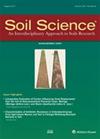Accuracy of regional-to-global soil maps for on-farm decision-making: are soil maps “good enough”?
4区 农林科学
Q2 Agricultural and Biological Sciences
引用次数: 7
Abstract
Abstract. A major obstacle to selecting the most appropriate crops and closing the yield gap in many areas of the world is a lack of site-specific soil information. Accurate information on soil properties is critical for identifying soil limitations and the management practices needed to improve crop yields. However, acquiring accurate soil information is often difficult due to the high spatial and temporal variability of soil properties at fine scales and the cost and inaccessibility of laboratory-based soil analyses. With recent advancements in predictive soil mapping, there is a growing expectation that soil map predictions can provide much of the information needed to inform soil management. Yet, it is unclear how accurate current soil map predictions are at scales relevant to management. The main objective of this study was to address this issue by evaluating the site-specific accuracy of regional-to-global soil maps, using Ghana as a test case. Four web-based soil maps of Ghana were evaluated using a dataset of 6514 soil profile descriptions collected on smallholder farms using the LandPKS mobile application. Results from this study revealed that publicly available soil maps in Ghana lack the needed accuracy (i.e., correct identification of soil limitations) to reliably inform soil management decisions at the 1–2 ha scale common to smallholders. Standard measures of map accuracy for soil texture class and rock fragment class predictions showed that all soil maps had similar performance in estimating the correct property class. Overall soil texture class accuracies ranged from 8 %–14 % but could be as high as 38 %–64 % after accounting for uncertainty in the evaluation dataset. Soil rock fragment class accuracies ranged from 26 %–29 %. However, despite these similar overall accuracies, there were substantial differences in soil property predictions among the four maps, highlighting that soil map errors are not uniform between maps. To better understand the functional implications of these soil property differences, we used a modified version of the FAO Global Agro-Ecological Zone (GAEZ) soil suitability modeling framework to derive soil suitability ratings for each soil data source. Using a low-input, rain-fed, maize production scenario, we evaluated the functional accuracy of map-based soil property estimates. This analysis showed that soil map data significantly overestimated crop suitability for over 65 % of study sites, potentially leading to ineffective agronomic investments by farmers, including cash-constrained smallholders.用于农业决策的区域到全球土壤地图的准确性:土壤地图“足够好”吗?
摘要在世界上许多地区,选择最合适的作物和缩小产量差距的一个主要障碍是缺乏特定地点的土壤信息。关于土壤特性的准确信息对于确定土壤限制和提高作物产量所需的管理措施至关重要。然而,由于土壤性质在精细尺度上的高时空变异性,以及基于实验室的土壤分析的成本和难以获得性,获取准确的土壤信息往往很困难。随着预测土壤制图的最新进展,人们越来越期望土壤制图预测能够提供土壤管理所需的许多信息。然而,目前尚不清楚当前土壤地图预测在与管理相关的尺度上有多准确。本研究的主要目的是通过评估区域到全球土壤地图的特定地点准确性来解决这一问题,并以加纳为最新案例。使用landpks移动应用程序从小农农场收集的6514个土壤轮廓描述数据集,对加纳的四个基于网络的土壤地图进行了评估。这项研究的结果表明,加纳公开可用的土壤地图缺乏所需的准确性(即正确识别土壤限制),无法可靠地为小农常见的1-2公顷规模的土壤管理决策提供信息。对土壤质地类和岩石碎片类预测的地图精度的标准测量表明,所有土壤图在估计正确的属性类方面具有相似的性能。总体土壤质地分类精度范围为8% - 14%,但考虑到评估数据集的不确定性后,可能高达38% - 64%。土壤岩石碎片分类精度范围为26% - 29%。然而,尽管总体精度相似,但四幅地图在土壤性质预测方面存在实质性差异,突出表明土壤地图的误差在地图之间并不均匀。为了更好地理解这些土壤性质差异的功能含义,我们使用了改良版的粮农组织全球农业生态区(GAEZ)土壤适宜性建模框架,得出每个土壤数据源的土壤适宜性评级。使用低投入、雨养、玉米生产场景,我们评估了基于地图的土壤属性估算的功能准确性。该分析表明,土壤地图数据严重高估了65%以上研究地点的作物适宜性,这可能导致农民(包括资金紧张的小农)的农业投资无效。
本文章由计算机程序翻译,如有差异,请以英文原文为准。
求助全文
约1分钟内获得全文
求助全文
来源期刊

Soil Science
农林科学-土壤科学
CiteScore
2.70
自引率
0.00%
发文量
0
审稿时长
4.4 months
期刊介绍:
Cessation.Soil Science satisfies the professional needs of all scientists and laboratory personnel involved in soil and plant research by publishing primary research reports and critical reviews of basic and applied soil science, especially as it relates to soil and plant studies and general environmental soil science.
Each month, Soil Science presents authoritative research articles from an impressive array of discipline: soil chemistry and biochemistry, physics, fertility and nutrition, soil genesis and morphology, soil microbiology and mineralogy. Of immediate relevance to soil scientists-both industrial and academic-this unique publication also has long-range value for agronomists and environmental scientists.
 求助内容:
求助内容: 应助结果提醒方式:
应助结果提醒方式:


